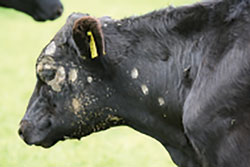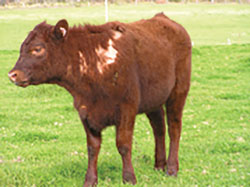What is the difference?
I am often asked what the difference is between lice and ringworm on cattle. Both conditions involve hair loss and rubbing and often involve a number of animals in the herd. The two conditions can generally be differentiated by the type of skin lesions and the age of the animal as well as the time of the year.

With ringworm, which is caused by a fungal infection of the skin, the hair loss is always in discrete roundish “punched-out’ type lesions more commonly located around the head and neck but can extend over the body. Often there is circular hair loss around one or both eyes. The common time of year for this to occur is the autumn (warm & moist) and the outbreaks normally occur in mobs of young cattle. This is because after infection the cattle become immune.

With lice, the hair loss can vary with the type of lice causing the infestation. But is generally around the neck although it can extend towards the head of the animal or towards the shoulder and over the trunk of the animal. The hair loss is very irregular in nature and generally involves quite large patches. Generally the lice are quite easy to see. All animals in the mob can be affected cows, bulls and weaners. Lice hate light so infestations generally start in the autumn but only show symptoms as the lice build up over the winter and spring and tend to disappear when the animals cut their coat for the summer.
What is the treatment?
Treatments and control vary markedly so a good diagnosis is important.
With ringworm the condition can be treated, but in Australia all treatments involve numerous individual frequent topical antifungal treatments. So, unless we are treating a small stud show team, treatment is impractical and not possible. Immunity develops in affected animals and the condition generally disappears over 8 – 16 weeks. The spread amongst a mob of young cattle can often be lessened by removing infected animals into a hospital mob as soon as you see the condition develop. A point to note is that cattle ringworm is the most serious form of ringworm in Humans. Most Cattlemen are immune but if children who are not often around cattle get a weepy skin lesion, get it checked out for ringworm.
With lice treatment, there is plenty of debate around whether you should treat lice in cattle. However I have a couple of mantra’s that ‘you should attempt to always have your cattle in a saleable condition’ and ‘unhappy host – happy parasite’, so if lice are really obvious in your herd or if the cattle are ‘down’ for other reasons then you should treat if possible.
Treatment involves a lice specific backline product (generally a pyrethroid such as permethrin) or a multi purpose worm and lice product such as Vetmec Pour-on. Just remember the mectin pour-on hasn’t the length of residual activity as the pyrethroid products so make sure that when you treat, treat all animals that are going to contact each other through until the summer. Injectable ‘mectin’ products such as Vetmec F are also super effective against sucking lice, however can be less so against biting lice.
Summary
| Ringworm | Lice | |
| Time of year | Autumn | Winter /Spring |
| Hair loss | Often head eyes and neck | Generally neck shoulders trunk |
| Animals affected | Weaner/yearlings | All ages |
| Treatment | Generally not practicable | Vetmec Pour-on or a Pyrethroid pouron |
